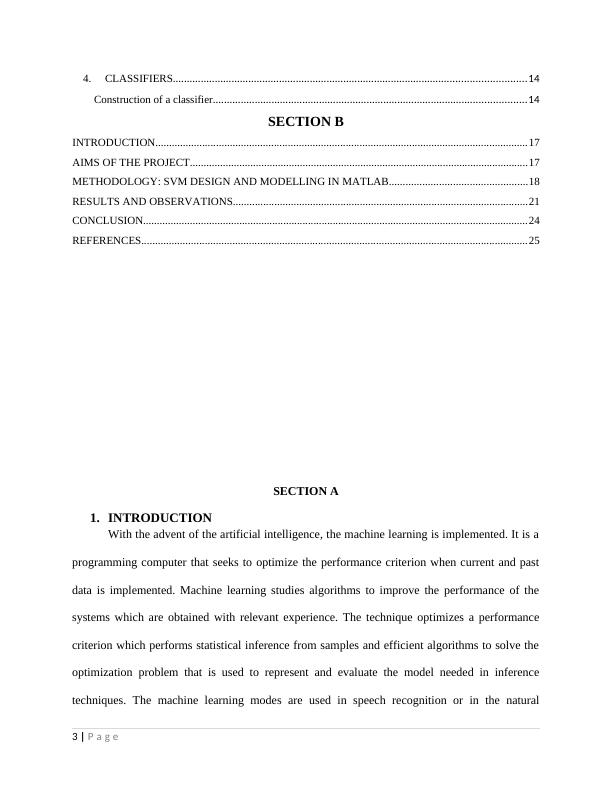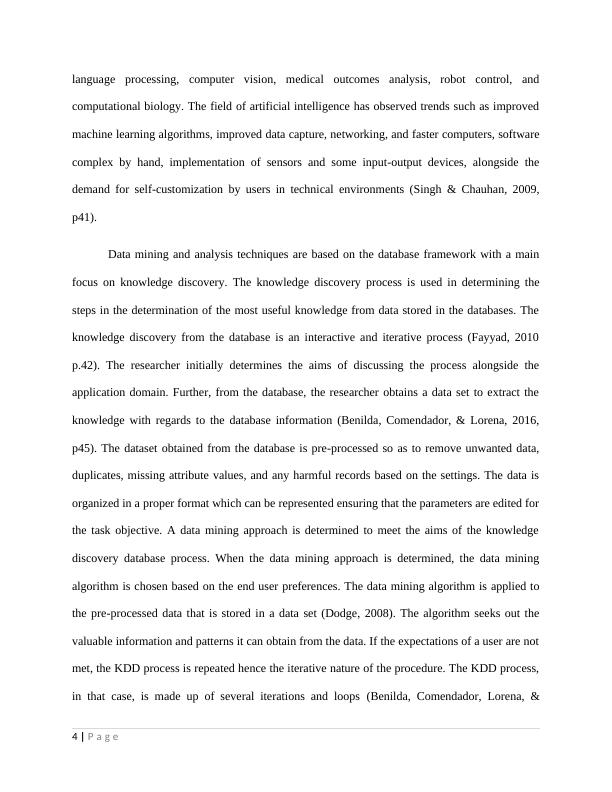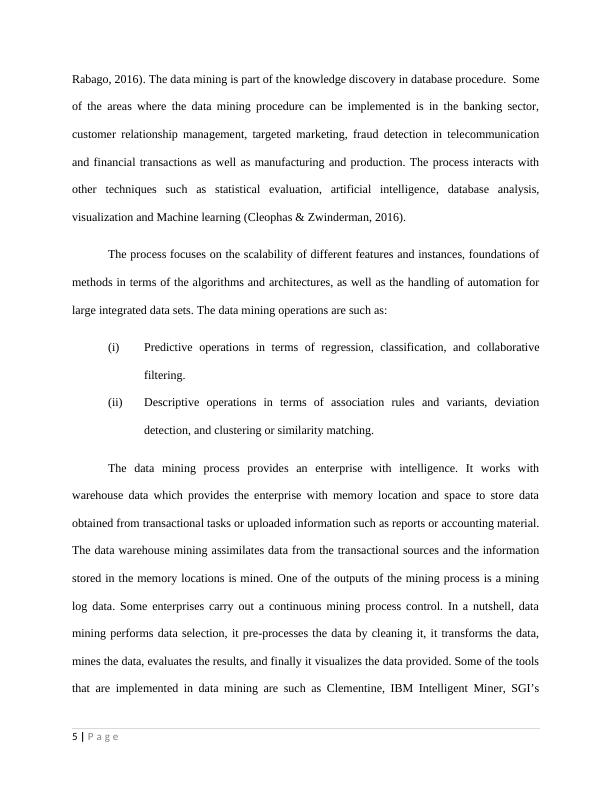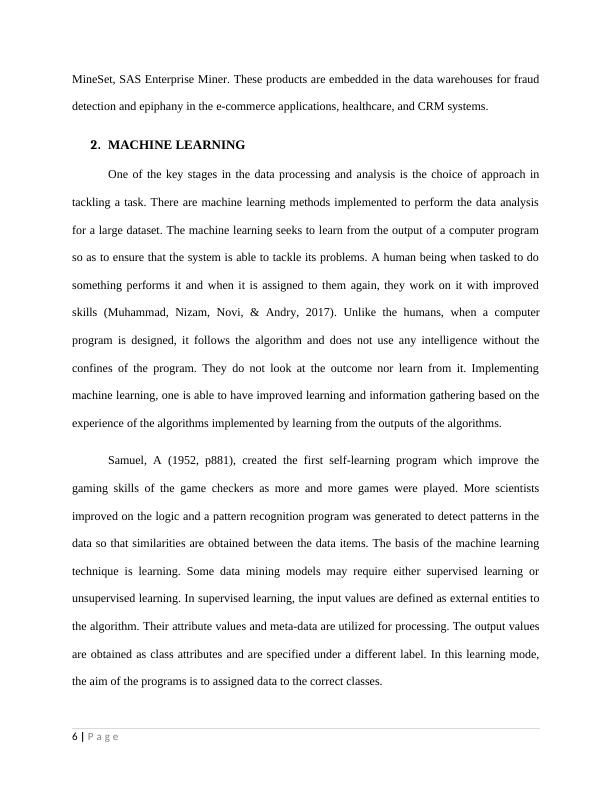Construction of a Simple Machine Learning SVM Classifier in MATLAB
Concerning copyright and translation: For all instruments we have received written approval to use and translate them, if not stated otherwise or if they have to be ordered separately (CBCL, CTQ, WASI/WISC-III/WISC-IV).
27 Pages4516 Words281 Views
Added on 2023-04-21
About This Document
This document provides a step-by-step guide on how to construct a simple machine learning SVM classifier in MATLAB. It covers the basics of machine learning and explains the implementation of support vector machines. The document also includes an introduction to machine learning and the different types of learning modes.
Construction of a Simple Machine Learning SVM Classifier in MATLAB
Concerning copyright and translation: For all instruments we have received written approval to use and translate them, if not stated otherwise or if they have to be ordered separately (CBCL, CTQ, WASI/WISC-III/WISC-IV).
Added on 2023-04-21
ShareRelated Documents
1 | P a g e

CONSTRUCTION OF A SIMPLE MACHINE LEARNING SVM CLASSIFIER IN
MATLAB
Table of Contents
SECTION
A
1. INTRODUCTION...........................................................................................................................3
2. MACHINE LEARNING.................................................................................................................5
a) Decision Trees...........................................................................................................................10
b) Support vector machines............................................................................................................12
2 | P a g e
Student Name
Student ID Number
Date of submission
MATLAB
Table of Contents
SECTION
A
1. INTRODUCTION...........................................................................................................................3
2. MACHINE LEARNING.................................................................................................................5
a) Decision Trees...........................................................................................................................10
b) Support vector machines............................................................................................................12
2 | P a g e
Student Name
Student ID Number
Date of submission

4. CLASSIFIERS..............................................................................................................................14
Construction of a classifier................................................................................................................14
SECTION B
INTRODUCTION.......................................................................................................................................17
AIMS OF THE PROJECT...........................................................................................................................17
METHODOLOGY: SVM DESIGN AND MODELLING IN MATLAB..................................................18
RESULTS AND OBSERVATIONS...........................................................................................................21
CONCLUSION............................................................................................................................................24
REFERENCES............................................................................................................................................25
SECTION A
1. INTRODUCTION
With the advent of the artificial intelligence, the machine learning is implemented. It is a
programming computer that seeks to optimize the performance criterion when current and past
data is implemented. Machine learning studies algorithms to improve the performance of the
systems which are obtained with relevant experience. The technique optimizes a performance
criterion which performs statistical inference from samples and efficient algorithms to solve the
optimization problem that is used to represent and evaluate the model needed in inference
techniques. The machine learning modes are used in speech recognition or in the natural
3 | P a g e
Construction of a classifier................................................................................................................14
SECTION B
INTRODUCTION.......................................................................................................................................17
AIMS OF THE PROJECT...........................................................................................................................17
METHODOLOGY: SVM DESIGN AND MODELLING IN MATLAB..................................................18
RESULTS AND OBSERVATIONS...........................................................................................................21
CONCLUSION............................................................................................................................................24
REFERENCES............................................................................................................................................25
SECTION A
1. INTRODUCTION
With the advent of the artificial intelligence, the machine learning is implemented. It is a
programming computer that seeks to optimize the performance criterion when current and past
data is implemented. Machine learning studies algorithms to improve the performance of the
systems which are obtained with relevant experience. The technique optimizes a performance
criterion which performs statistical inference from samples and efficient algorithms to solve the
optimization problem that is used to represent and evaluate the model needed in inference
techniques. The machine learning modes are used in speech recognition or in the natural
3 | P a g e

language processing, computer vision, medical outcomes analysis, robot control, and
computational biology. The field of artificial intelligence has observed trends such as improved
machine learning algorithms, improved data capture, networking, and faster computers, software
complex by hand, implementation of sensors and some input-output devices, alongside the
demand for self-customization by users in technical environments (Singh & Chauhan, 2009,
p41).
Data mining and analysis techniques are based on the database framework with a main
focus on knowledge discovery. The knowledge discovery process is used in determining the
steps in the determination of the most useful knowledge from data stored in the databases. The
knowledge discovery from the database is an interactive and iterative process (Fayyad, 2010
p.42). The researcher initially determines the aims of discussing the process alongside the
application domain. Further, from the database, the researcher obtains a data set to extract the
knowledge with regards to the database information (Benilda, Comendador, & Lorena, 2016,
p45). The dataset obtained from the database is pre-processed so as to remove unwanted data,
duplicates, missing attribute values, and any harmful records based on the settings. The data is
organized in a proper format which can be represented ensuring that the parameters are edited for
the task objective. A data mining approach is determined to meet the aims of the knowledge
discovery database process. When the data mining approach is determined, the data mining
algorithm is chosen based on the end user preferences. The data mining algorithm is applied to
the pre-processed data that is stored in a data set (Dodge, 2008). The algorithm seeks out the
valuable information and patterns it can obtain from the data. If the expectations of a user are not
met, the KDD process is repeated hence the iterative nature of the procedure. The KDD process,
in that case, is made up of several iterations and loops (Benilda, Comendador, Lorena, &
4 | P a g e
computational biology. The field of artificial intelligence has observed trends such as improved
machine learning algorithms, improved data capture, networking, and faster computers, software
complex by hand, implementation of sensors and some input-output devices, alongside the
demand for self-customization by users in technical environments (Singh & Chauhan, 2009,
p41).
Data mining and analysis techniques are based on the database framework with a main
focus on knowledge discovery. The knowledge discovery process is used in determining the
steps in the determination of the most useful knowledge from data stored in the databases. The
knowledge discovery from the database is an interactive and iterative process (Fayyad, 2010
p.42). The researcher initially determines the aims of discussing the process alongside the
application domain. Further, from the database, the researcher obtains a data set to extract the
knowledge with regards to the database information (Benilda, Comendador, & Lorena, 2016,
p45). The dataset obtained from the database is pre-processed so as to remove unwanted data,
duplicates, missing attribute values, and any harmful records based on the settings. The data is
organized in a proper format which can be represented ensuring that the parameters are edited for
the task objective. A data mining approach is determined to meet the aims of the knowledge
discovery database process. When the data mining approach is determined, the data mining
algorithm is chosen based on the end user preferences. The data mining algorithm is applied to
the pre-processed data that is stored in a data set (Dodge, 2008). The algorithm seeks out the
valuable information and patterns it can obtain from the data. If the expectations of a user are not
met, the KDD process is repeated hence the iterative nature of the procedure. The KDD process,
in that case, is made up of several iterations and loops (Benilda, Comendador, Lorena, &
4 | P a g e

Rabago, 2016). The data mining is part of the knowledge discovery in database procedure. Some
of the areas where the data mining procedure can be implemented is in the banking sector,
customer relationship management, targeted marketing, fraud detection in telecommunication
and financial transactions as well as manufacturing and production. The process interacts with
other techniques such as statistical evaluation, artificial intelligence, database analysis,
visualization and Machine learning (Cleophas & Zwinderman, 2016).
The process focuses on the scalability of different features and instances, foundations of
methods in terms of the algorithms and architectures, as well as the handling of automation for
large integrated data sets. The data mining operations are such as:
(i) Predictive operations in terms of regression, classification, and collaborative
filtering.
(ii) Descriptive operations in terms of association rules and variants, deviation
detection, and clustering or similarity matching.
The data mining process provides an enterprise with intelligence. It works with
warehouse data which provides the enterprise with memory location and space to store data
obtained from transactional tasks or uploaded information such as reports or accounting material.
The data warehouse mining assimilates data from the transactional sources and the information
stored in the memory locations is mined. One of the outputs of the mining process is a mining
log data. Some enterprises carry out a continuous mining process control. In a nutshell, data
mining performs data selection, it pre-processes the data by cleaning it, it transforms the data,
mines the data, evaluates the results, and finally it visualizes the data provided. Some of the tools
that are implemented in data mining are such as Clementine, IBM Intelligent Miner, SGI’s
5 | P a g e
of the areas where the data mining procedure can be implemented is in the banking sector,
customer relationship management, targeted marketing, fraud detection in telecommunication
and financial transactions as well as manufacturing and production. The process interacts with
other techniques such as statistical evaluation, artificial intelligence, database analysis,
visualization and Machine learning (Cleophas & Zwinderman, 2016).
The process focuses on the scalability of different features and instances, foundations of
methods in terms of the algorithms and architectures, as well as the handling of automation for
large integrated data sets. The data mining operations are such as:
(i) Predictive operations in terms of regression, classification, and collaborative
filtering.
(ii) Descriptive operations in terms of association rules and variants, deviation
detection, and clustering or similarity matching.
The data mining process provides an enterprise with intelligence. It works with
warehouse data which provides the enterprise with memory location and space to store data
obtained from transactional tasks or uploaded information such as reports or accounting material.
The data warehouse mining assimilates data from the transactional sources and the information
stored in the memory locations is mined. One of the outputs of the mining process is a mining
log data. Some enterprises carry out a continuous mining process control. In a nutshell, data
mining performs data selection, it pre-processes the data by cleaning it, it transforms the data,
mines the data, evaluates the results, and finally it visualizes the data provided. Some of the tools
that are implemented in data mining are such as Clementine, IBM Intelligent Miner, SGI’s
5 | P a g e

MineSet, SAS Enterprise Miner. These products are embedded in the data warehouses for fraud
detection and epiphany in the e-commerce applications, healthcare, and CRM systems.
2. MACHINE LEARNING
One of the key stages in the data processing and analysis is the choice of approach in
tackling a task. There are machine learning methods implemented to perform the data analysis
for a large dataset. The machine learning seeks to learn from the output of a computer program
so as to ensure that the system is able to tackle its problems. A human being when tasked to do
something performs it and when it is assigned to them again, they work on it with improved
skills (Muhammad, Nizam, Novi, & Andry, 2017). Unlike the humans, when a computer
program is designed, it follows the algorithm and does not use any intelligence without the
confines of the program. They do not look at the outcome nor learn from it. Implementing
machine learning, one is able to have improved learning and information gathering based on the
experience of the algorithms implemented by learning from the outputs of the algorithms.
Samuel, A (1952, p881), created the first self-learning program which improve the
gaming skills of the game checkers as more and more games were played. More scientists
improved on the logic and a pattern recognition program was generated to detect patterns in the
data so that similarities are obtained between the data items. The basis of the machine learning
technique is learning. Some data mining models may require either supervised learning or
unsupervised learning. In supervised learning, the input values are defined as external entities to
the algorithm. Their attribute values and meta-data are utilized for processing. The output values
are obtained as class attributes and are specified under a different label. In this learning mode,
the aim of the programs is to assigned data to the correct classes.
6 | P a g e
detection and epiphany in the e-commerce applications, healthcare, and CRM systems.
2. MACHINE LEARNING
One of the key stages in the data processing and analysis is the choice of approach in
tackling a task. There are machine learning methods implemented to perform the data analysis
for a large dataset. The machine learning seeks to learn from the output of a computer program
so as to ensure that the system is able to tackle its problems. A human being when tasked to do
something performs it and when it is assigned to them again, they work on it with improved
skills (Muhammad, Nizam, Novi, & Andry, 2017). Unlike the humans, when a computer
program is designed, it follows the algorithm and does not use any intelligence without the
confines of the program. They do not look at the outcome nor learn from it. Implementing
machine learning, one is able to have improved learning and information gathering based on the
experience of the algorithms implemented by learning from the outputs of the algorithms.
Samuel, A (1952, p881), created the first self-learning program which improve the
gaming skills of the game checkers as more and more games were played. More scientists
improved on the logic and a pattern recognition program was generated to detect patterns in the
data so that similarities are obtained between the data items. The basis of the machine learning
technique is learning. Some data mining models may require either supervised learning or
unsupervised learning. In supervised learning, the input values are defined as external entities to
the algorithm. Their attribute values and meta-data are utilized for processing. The output values
are obtained as class attributes and are specified under a different label. In this learning mode,
the aim of the programs is to assigned data to the correct classes.
6 | P a g e

End of preview
Want to access all the pages? Upload your documents or become a member.
Related Documents
History of Data Mining (pdf)lg...
|7
|1587
|459
Data Mining: Milestones, Impact and Future Scopelg...
|11
|2143
|233
Machine Learning Application: Data Science Practicelg...
|13
|3166
|445
IT Infrastructure Management: ERM, Business Intelligence, Cloud Computing, and Morelg...
|11
|1585
|92
